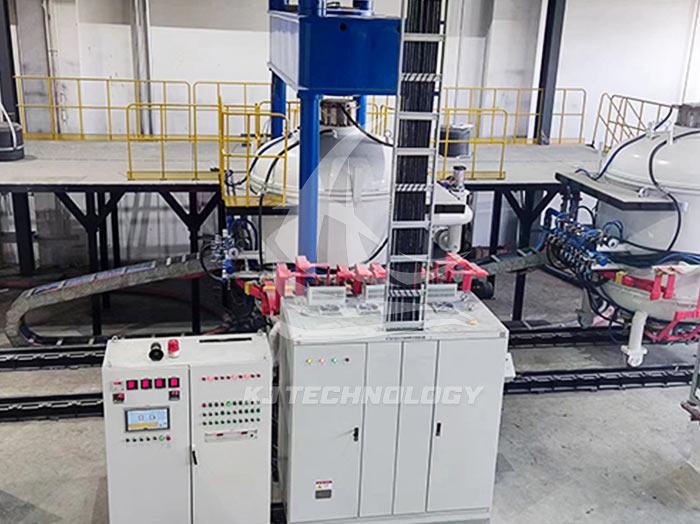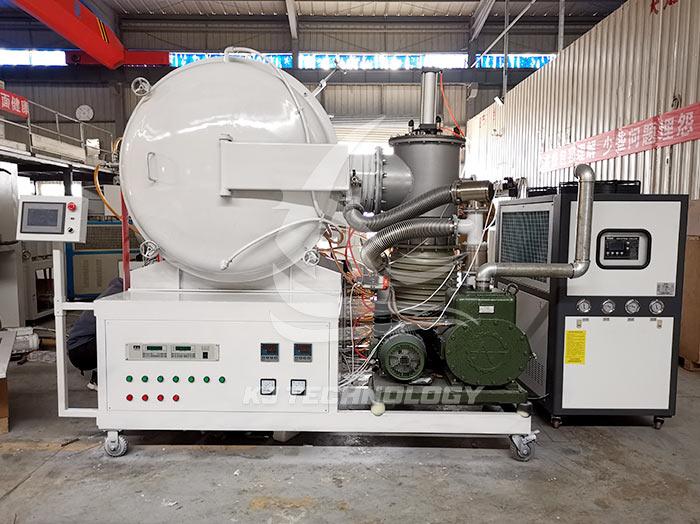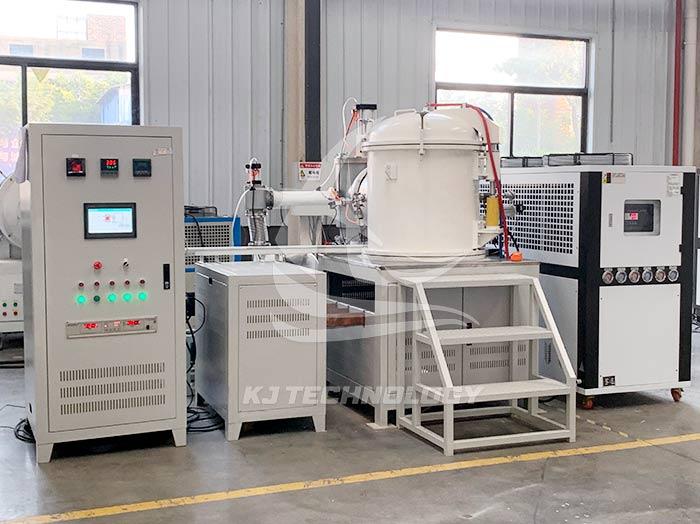Vacuum aluminum brazing furnace
 06-12-2025 Author: KJ technology
06-12-2025 Author: KJ technology
Vacuum aluminum brazing furnace is a process equipment used for vacuum brazing and heat treatment of various materials such as aluminum alloy, stainless steel, titanium alloy, etc. The following introduces the characteristics, application fields, operating procedures, maintenance and repair of the equipment:
Equipment features
Vacuum environment: The air inside the furnace is extracted by a vacuum pump to achieve a certain degree of vacuum, reducing or avoiding the oxidation and pollution of metal materials during the brazing process.
Temperature control: Adopting zone heaters to ensure temperature uniformity, the working temperature range varies depending on the model, with a maximum of 750 ℃.
Cooling method: Processing is completed under the forced cooling of high-purity nitrogen, equipped with an internal circulation cooling device, which can accelerate the cooling of materials in the furnace, shorten the working cycle, and improve product quality and work efficiency.
Application area
Automotive industry: mainly used for brazing aluminum heat exchangers, waveguides, and other components in the automotive air conditioning and construction machinery industries.
In the field of heat treatment, it can be used for heat treatment of materials such as high-speed steel and mold steel, as well as processes such as brazing and vacuum tempering of stainless steel, titanium alloys, hard alloys, high-temperature alloys, and non-ferrous metals.
Other industries: Suitable for brazing production of aluminum parts under protective atmosphere, such as aluminum water tanks, oil coolers, intercoolers, warm air, tube and belt condensers, evaporators, parallel flow condensers, stacked evaporators, power plant air coolers, etc. Continuous brazing of workpieces under nitrogen protective atmosphere.
Operating procedures
Preparation before operation
Operators are required to wear protective clothing, goggles, and gloves.
Ensure that the equipment power is properly grounded and check if the electrical wiring is functioning properly.
Check the vacuum pump to ensure it is working properly.
Clean and inspect the furnace chamber to ensure there are no residues or damage.
Check the temperature and pressure gauges of the equipment to ensure their sensitivity and accuracy.
Ensure that the operating area is clean, free of debris or flammable materials, and prohibit any personnel from standing above the equipment or near the furnace door.
Operation process
Turn on the power switch of the vacuum aluminum brazing furnace, start the vacuum pump, close the furnace door, and ensure good sealing.
Set the required brazing temperature and time, start the heater and heat according to the temperature setting.
During the heating process, regularly check the readings of the thermometer and pressure gauge to ensure that the temperature and pressure are within the set range.
Place the aluminum material to be brazed into the furnace chamber within the required heating time, ensuring that the material is placed properly and does not collide. Pay attention to temperature and pressure changes during the brazing process, and adjust the temperature setting of the heater as needed.
After brazing is completed, turn off the heater, remove the material to be brazed, turn off the power switch and vacuum pump of the vacuum aluminum brazing furnace, and clean and organize the equipment.
Maintenance and repair
Daily cleaning
The outer surface of the furnace and control cabinet should be regularly wiped to maintain cleanliness and hygiene. When cleaning equipment, the power supply and compressed air should be cut off. When the furnace is dirty or dusty, use a silk cloth soaked in acetone or anhydrous alcohol to wipe it clean and dry it.
Regularly clean the magnesium blocks on the inner wall of the furnace door once a month.
Component inspection and replacement
Do not restart without preheating after prolonged use. When restarting, bake at a temperature of 620 degrees Celsius and maintain a vacuum degree of less than 10 ⁻ Pa for one hour.
Before each shift, check if the circulating water tank is sufficient. If not, add cooling water. The pressure of the cooling water should be greater than 0.1MPa. Otherwise, check the water filter screen; The compressed air pressure should be greater than 0.5 MPa, otherwise check whether the pipeline leaks. The furnace can only be started after the pressure reaches the specified value.
During the welding process, the external temperature of the furnace body, diffusion pump, cold trap, magnesium remover and other vacuum pumps should be regularly checked. When the temperature is too high, the cooling water pipeline should be checked and cleaned in a timely manner.
When disassembling and assembling seals, clean them with acetone or anhydrous alcohol, dry them, and apply vacuum grease; The electrical connectors of the electrical control system should be kept clean and tightened, and each tightened electrical connector should be checked before tightening.
The insulation resistance of the furnace should be checked regularly, and its value should not be less than 100 Ω. When it is less than 100 Ω, the resistance of the electric heating elements, insulators, electrodes, and heat shields should be carefully checked, and faults should be promptly eliminated before starting the furnace.
Mechanical transmission components should be lubricated regularly or according to general equipment lubrication requirements.
Vacuum devices, valves, SCR regulators, instruments, and other accessories should be repaired and maintained according to the manufacturer's instructions.
Workpieces and fixtures should be clean and dry to prevent moisture and dirt from entering the furnace.
Vacuum pump maintenance
Always pay attention to the oil level, which is the standard of the center of the oil gauge when the pump is running normally. When the oil level is lower than the center of the oil gauge, oil should be added. The oil change cycle is determined by the user based on the usage conditions and whether it can meet the performance requirements. Generally, it is recommended to change the oil every 100 hours for new pumps. If there is no black metal powder in the oil, the oil change cycle can be extended. The pump oil should generally be SY1634-701 vacuum pump oil and should not be mixed with kerosene or gasoline.
Regular attention should be paid to the oil level and oil cleanliness. The oil should be changed every 150 hours after a new pump is installed, and every 2-3 months after the oil change. If the operating conditions are poor and the vacuum drops, the oil change time can be shortened.
In the cold zone, the water in the cooling water jacket must be completely drained after parking, otherwise the water in the jacket will freeze and damage the pump casing.
If not in use for a long time, turn on the pump every 7-10 days for about 1 hour to prevent rusting inside the pump.
The pump room should be kept clean and dry regularly, and attention should be paid to lubrication of all parts. If insufficient lubricating oil is found, it should be replenished in a timely manner. If the lubricating oil is found to be unclean, it should be replaced in a timely manner. The new pump should be replaced after 30-50 hours of use, and the use of oil circulation can be determined according to the situation in the future.
During the operation of the diffusion pump, it is necessary to ensure that the cooling water is unobstructed. After stopping heating, the cooling water can only be turned off after the working fluid of the pump has completely cooled down.
When the diffusion pump stops working, the vacuum inside the pump should be maintained to prevent the pump oil from deteriorating. The emitted gas should be dry, non corrosive, and dust-free.
If the diffusion pump is not used temporarily, it should be stored in a vacuum state to avoid oil stains and corrosion of various parts, and the remaining water in the cooling jacket should be cleaned.
After long-term operation, the performance of the diffusion pump will gradually deteriorate. Regular maintenance should be carried out to check whether the pump oil has reduced or oxidized, and to add or replace it according to the corresponding requirements. The parts and pump chamber are cleaned with aviation gasoline, then soaked in silk in ether or acetone for cleaning, and dried at 80-100 ℃ or blown dry with a blower. After processing, they are assembled in sequence, keeping the pump core and pump bottom perpendicular to the pump chamber and concentric. The gap between each nozzle should be adjusted according to the original requirements.








